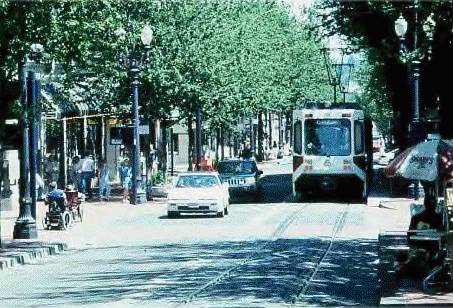
Portland's
LRT system is compatible with neighborhoods, pedestrians, street traffic. Photo: ExpoRail
Light Rail Now and Walkable Neighborhoods (LRN) can be contacted at: Light Rail Now! |
Austin Light Rail Plan: Support Grows As public support continues to increase for Capital Metro's proposed light rail transit (LRT) system for Austin - including the 14.6-mile starter line from northwest Austin to downtown, sketched in our last report - the battle for public confidence has also intensified. At stake: the Nov. 7th vote to approve or veto LRT and a new mobility alternative for Austin's future. Crucial to winning voters' endorsement is the struggle for support from neighborhood residents and associations. LRT proponents underscore the fact that LRT strengthens existing neighborhoods while attracting clusters of development around transit stations in more lightly developed areas, and that LRT is a powerful tool to deal with urban sprawl. In city after city where light rail has been installed, neighborhood integrity has been preserved while urban livability has increased. But many neighborhood residents and association activists have been spooked by the city's talk of "compact city," dense development zones around light rail and bus stations. They fear light rail will spur increased development in these corridors.
Many of these issues were addressed by 'San Antonio Express-News' columnist Mike Greenberg. In a July 6 commentary on the recent "New Urbanism" conference in Portland. "A lot of people", Greenberg points out, "... equate "density" with crowded slums or skyscraper canyons." But, he argues, density doesn't have to mean highrises and crowded streets. Instead, moderate development can mean "livability, walkability, convenience, choice, economic opportunity." "In general," Greenberg notes, "density is a sign of success, not of failure. Neighborhoods grow denser because folks want to live there." Greenberg also turns to the problem of "gentrification": "When neighborhoods improve, real estate values inevitably rise. Rising taxes and rents may force out the poor ...." Light rail can nudge up property values, and bolster improvements in neighborhood quality-of-life. But that also doesn't have to mean trampling on the well-being of current neighborhood residents, says Greenberg. "There's no easy cure for gentrification, but the interests of the poor and middle class can be protected to some degree through development regulations and housing and tax policy", he points out, adding, "Anyway, a little gentrification is better than a lot of blight." The best evidence that LRT bolsters neighborhoods, rather than threatens them, is the example of existing LRT systems. In cities like Sacramento, San Francisco, Philadelphia, Portland, and Boston, LRT lines run right through neighborhoods and past people's homes. The result: Most neighbors say it's a good neighbor! Electrically-propelled LRT trains are quiet, free of fumes, and user-friendly. In central areas (like downtown Dallas) pedestrians stroll across the tracks - no problem. Portland, Oregon is cited as the most livable city in the US, partly for its MAX LRT system, whose ridership has skyrocketed to over 62,000 a day. Along the route, existing neighborhoods have been preserved and reinforced, while new development has clustered at some stations and run- down areas have been revitalized. Along MAX's Burnside Ave. In Portland, the LRT line goes right down the middle of the street, past residents' front yards. Residents' reaction? Unanimously positive ... no problem. Some might use it, some might not - but they certainly don't mind LRT being there. There's no highrise development, no high-density property buyouts, no out-of- sight property taxes. Basically, MAX is seen as an asset to the existing neighborhood. In Boston, the Riverside LRT line goes right past neighborhood back yards. A 1990 survey asked for residents' reactions. The result: Nearly 77% said LRT was a benefit; only 10% said there was a problem. Nevertheless, a kind of hysteria over LRT has spread among some Austin neighborhood residents and leaders - hysteria gladly spread by anti-transit activists such as those in ROAD (Reclaim Our Allocated Dollers), an anti-LRT group which seeks to "reclaim" Capital Metro revenues to build more highways. ROAD zealots have adopted a "neighborhood lovers" role, posturing as the neighborhoods' "protectors" against the evil light rail plan. Yet these same ROAD Warriors can be counted on to drive the bulldozers straight through those same neighborhoods if it's a highway project on the table. Indeed, one of ROAD's central goals is a revival of the "crosstown freeway" proposal - the plan successfully defeated nearly a decade ago by neighborhoods along Koenig Lane. Aiding ROAD's scheme, TxDOT highway builders are poised to drive a US 290 freeway westward from I-35, especially now that direct- connector lanes to funnel traffic into Koenig Lane are being installed. Defeat of the LRT proposal would be a major boost to ROAD's highway-expansion plans. On the other hand, approval of LRT on Nov. 7th could point the way toward a totally different approach to meeting Austintes' mobility needs - in which LRT would play a major part. Will Austin's future consist
of more traffic tie-ups, more ozone, more homes and businesses condemned
to cut swaths for freeways ... or quiet, fast, pollution-free electric
light rail trains linking a grid of efficient bus routes, bikeways, and
sidewalks in a new mobility lifestyle? Neighborhood support may be a crucial
factor in deciding the outcome. Rev. 00/08/19 |
|
|
|